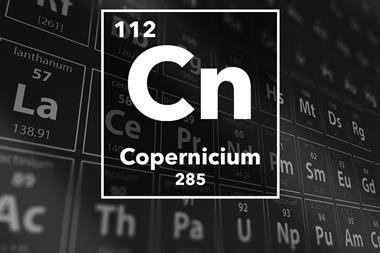Copernicium – one of the longest-lived superheavy elements – should behave more like a noble gas than the noble gas group element in the same period, oganesson, according to new computer simulations.1 The finding provides further evidence that relativity makes Mendeleev-style periodicity rules an ever-more unreliable guide to these enormous elements’ physical and chemical properties.
The electronic structure theory of atoms generally takes no account of relativity. However, as atomic nuclei become heavier, pulling electrons closer, electronic speeds approach the speed of light and relativistic effects become noticeable in elements’ properties. In the 1960s, for example, Pekka Pykkö – now at the University of Helsinki in Finland – showed that gold’s distinctive colour arises because the energy of its 6s orbital is reduced by relativistic contraction, causing the 5d→6s transition to be shifted down from ultraviolet frequencies to blue ones. Gold therefore absorbs blue light and reflects other wavelengths. Furthermore, in 2017, Peter Schwerdtfeger and colleagues at Massey University in New Zealand showed how relativity lowers the melting point of gold’s neighbour in the periodic table, mercury, by nearly 200ºC, by drawing bonding electrons closer to the nucleus and making metallic bonding less efficient. This explains why mercury – uniquely among the metals – is liquid at room temperature.
Relativistic effects should logically be most pronounced in the heaviest elements. Unfortunately, such atoms are usually extremely unstable: the half-life of the heaviest isotope yet confirmed – oganesson-294 – is under a millisecond, so direct chemical experiments are usually impossible. Theory, however, has made bizarre predictions: oganesson’s placing in the periodic table suggests it should be a noble gas, but Schwerdtfeger’s group recently predicted it is a metallic semiconductor.
Conversely, in their new work they conclude that copernicium, which sits directly below mercury in the periodic table, should be a highly volatile ‘noble liquid’ with a melting point of about 10ºC and a boiling point around 67ºC. This is consistent with a 1975 prediction from Kenneth Pitzer of University of California, Berkeley.3 However, in 2008, Robert Eichler at the Paul Scherrer Institute in Switzerland and colleagues measured a gas-phase interaction between copernicium atoms and a gold surface, which was seen as evidence of metallicity.4 Schwedtfeger’s team proposes that – unlike the lighter elements in group 12, which behave like alkaline earth metals – copernicium should be considered a d-block element. ‘The 6d orbital is actually above the 7s orbital in copernicium, so the bonding electrons are of d-character,’ says lead author Jan-Michael Mewes, now at the University of Bonn in Germany. Isotopes of copernicium can last for up to 29 seconds, meaning that it may be possible to test this hypothesis one day.
Eichler is impressed. He sees no contradiction between his own group’s experimental results and the theoretical modelling from Schwerdtfeger and colleagues. ‘If you look at our prediction from 2008 you get essentially the same prediction for the interaction energy of copernicium with itself,’ Eichler says. ‘Another metal such as gold can push copernicium to interact in a metallic way.’ Pykkö also finds the model ‘convincing’. He cautions, however, that it is ‘somewhat remote from experiment’, but says that ’[Schwerdtfeger] is one of the best experts to answer these questions’.
References
1 J Mewes et al, Angew. Chem., Int. Ed., 2019, DOI: 10.1002/anie.201906966
2 K G Steenbergen, E Pahl and P Schwerdtfeger, Phys. Chem. Lett., 2017, 87, 1407 (DOI: 10.1021/acs.jpclett.7b00354)
3 K S Pitzer, J. Chem. Phys., 1975, 63, 1032 (DOI: 10.1063/1.431398)
4 R Eichler et al, Angew. Chem., Int. Ed., 2008, 87, 3262 (DOI: 10.1002/anie.200705019)

















No comments yet